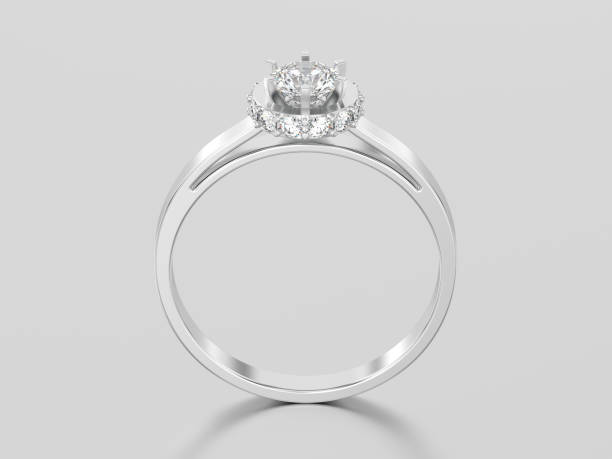
If you believe that an engagement ring design is incomplete without optimal sparkle, you should look for one with a pavé setting. This popular technique adds radiance without detracting from your center stone, as well as an artisanal touch that is equal parts bold and romantic.
The pavé setting is a type of ring setting that features small diamonds along the ring's band. The French term translates to "paved," and this jewelry technique was named after a paved or cobblestone road.
Pavé settings date back hundreds of years, with notable designs dating back to the Georgian era. This era's jewelry features diamonds and other stones, such as turquoise pavé, set in rings, lockets, brooches, earrings, and precious objects. The technique is accomplished by carving a hole (or divot) in the material and inserting a tiny gemstone. The stone is then held in place with eensy beads or another type of prong created with a metal tool. There are a few different ways to do this, and they all look slightly different in the end. But, in general, pavé adds a diamond or gem outline or all-over surface covering to the piece.
The reason for choosing a pavé setting is simple: more sparkle. Pavé settings are an excellent way to add sparkle to your ring. The diamonds are set with minimal metal to keep the focus on the center stone. They can also be set on very thin bands, making your ring appear delicate. Pavé settings are a great way to add bling to an engagement ring without taking the focus away from the center stone.
The pavé setting's delicacy is an obvious disadvantage. While the prominent design of pavé-set rings is often preferred by brides-to-be because it emphasizes the diamonds, it is more difficult to maintain than other styles. Pavé settings, like all fine jewelry, can be delicate, and because they have so many tiny stones set into the design, if your ring takes a hard hit, a stone may come loose.
In terms of cost, the majority of the cost for pavé jewelry is found in the labor. This type of work necessitates the use of skilled setters. Their artisanship is not only valuable, but it is also more expensive. It can cost several hundred dollars to several thousand dollars more than a traditional solitaire setting.
I love adding a hidden halo to an engagement ring by adding pavé to the basket bar (which supports the prongs on your ring) around the sides of your center stone. It's a nice little detail that you don't notice from the top of the ring, but it makes the sides of your ring just as unique and sparkly as the rest.
Pavé, in my opinion, is a lovely addition to any setting. We've combined pavé with both bezel-set and prong-set center stones. Micro-pavé is another technique that uses even smaller diamonds and is accomplished with the help of a microscope. This look is known as "diamond-dusted."
Small prongs in a pavé-set ring are more likely to bend if too much pressure is applied. As a result, we strongly advise using extra caution when wearing this style. But don't worry, replacing lost stones is a breeze!
Because pavé settings are more delicate, experts advise removing your ring before engaging in activities that could cause harm. These types of damages are not uncommon, and thankfully, jewelers can repair them relatively easily. When in doubt, remove your ring before engaging in any high-contact activities.
When it comes to cleaning, get your pavé setting steam cleaned and avoid using a polishing cloth "as the fibers can snag the tiny prongs." Landau suggests filling a bowl with warm water and a squirt of dish soap. Soak your jewelry in it and scrub it with a clean toothbrush to get into all the crevices. Then, rinse with warm water (no soap) and pat dry with a clean paper towel.
Sell your diamonds with ease with Diamond Registry’s comprehensive approach and vast global industry connections to help you find the best buyer for your diamond fast. Visit www.diamondregistry.com/sell-your-ring to take your first step to fast, easy and reliable way of selling your diamond.
Want to check and calculate diamond per carat instantly? Go to DR’s diamond price calculator to know how. Reliable and trusted carat calculator in the diamond industry since!

